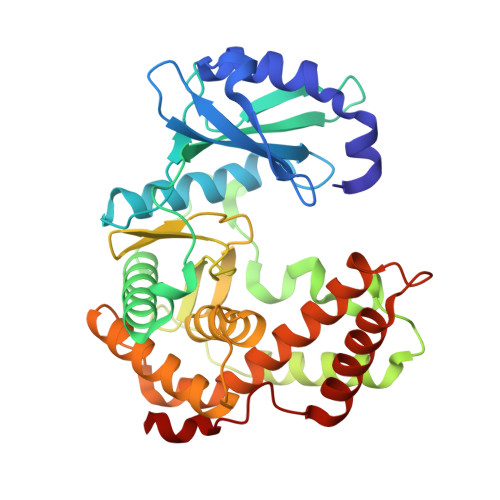A kinase bioscavenger provides antibiotic resistance by extremely tight substrate binding.
Terekhov, S.S., Mokrushina, Y.A., Nazarov, A.S., Zlobin, A., Zalevsky, A., Bourenkov, G., Golovin, A., Belogurov Jr., A., Osterman, I.A., Kulikova, A.A., Mitkevich, V.A., Lou, H.J., Turk, B.E., Wilmanns, M., Smirnov, I.V., Altman, S., Gabibov, A.G.(2020) Sci Adv 6: eaaz9861-eaaz9861
- PubMed: 32637600
- DOI: https://doi.org/10.1126/sciadv.aaz9861
- Primary Citation of Related Structures:
6SUI, 6SUL, 6SUM, 6SUN, 6SV5 - PubMed Abstract:
Microbial communities are self-controlled by repertoires of lethal agents, the antibiotics. In their turn, these antibiotics are regulated by bioscavengers that are selected in the course of evolution. Kinase-mediated phosphorylation represents one of the general strategies for the emergence of antibiotic resistance. A new subfamily of AmiN-like kinases, isolated from the Siberian bear microbiome, inactivates antibiotic amicoumacin by phosphorylation. The nanomolar substrate affinity defines AmiN as a phosphotransferase with a unique catalytic efficiency proximal to the diffusion limit. Crystallographic analysis and multiscale simulations revealed a catalytically perfect mechanism providing phosphorylation exclusively in the case of a closed active site that counteracts substrate promiscuity. AmiN kinase is a member of the previously unknown subfamily representing the first evidence of a specialized phosphotransferase bioscavenger.
- Shemyakin-Ovchinnikov Institute of Bioorganic Chemistry of the Russian Academy of Sciences, Moscow, Russia.
Organizational Affiliation:



















